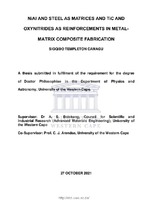| dc.contributor.advisor | Bolokang, A. S. | |
| dc.contributor.author | Camagu, Sigqibo Templeton | |
| dc.date.accessioned | 2022-01-18T13:35:28Z | |
| dc.date.available | 2022-01-18T13:35:28Z | |
| dc.date.issued | 2021 | |
| dc.identifier.uri | http://hdl.handle.net/11394/8607 | |
| dc.description | Philosophiae Doctor - PhD | en_US |
| dc.description.abstract | Metal matrix composites harness the superior attributes of their individual constituents to form high performance materials that would rather be impossible from monolithic substances. Owing to many possible combinations, a myriad of metal matrix composite systems can be fabricated with a metal (or a metal alloy) as a matrix (continuous) phase and a ceramic as a reinforcement (discontinuous) phase. The current study focuses on two matrices, namely Nickel Aluminide and Austenitic Steel as well as two reinforcements namely, Titanium Carbide and Oxynitrides. NiAl alloys are candidates for high temperature structural materials due to their high melting temperature, low density, good thermal conductivity, and excellent oxidation resistance. | en_US |
| dc.language.iso | en | en_US |
| dc.publisher | University of Western Cape | en_US |
| dc.subject | Nickel aluminium | en_US |
| dc.subject | Titanium carbide | en_US |
| dc.subject | Thermal behaviour | en_US |
| dc.subject | X ray diffraction | en_US |
| dc.subject | Oxidation | en_US |
| dc.title | Nial and steel as matrices and tic and oxynitrides as reinforcements in metal-matrix composite fabrication | en_US |
| dc.rights.holder | University of Western Cape | en_US |

